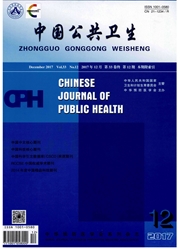

 中文摘要:
中文摘要:
目的了解深圳市30岁~居民碘营养状况,评价居民碘营养状况。方法采取整群、分层、随机抽样相结合的方法,于2008年8月在深圳市抽取2个社区30岁~居民277人作为调查对象,采其晨尿并进行尿碘水平检测。结果检测尿碘范围为12.0~1 705.5μg/L,尿碘中位数为167.7μg/L;尿碘水平〈50μg/L的人群占1.8%,〈100μg/L的占16.6%,100~199μg/L的占44.8%,200~300μg/L的占23.1%,〉300μg/L的占15.5%;各年龄组间尿碘中位数差异无统计学意义,但是尿碘水平与年龄呈负相关(r=-0.142,P=0.018);除40岁~年龄组尿碘水平略超出推荐适宜摄入量外,其余各年龄组尿碘中位数水平均在适宜范围内,且男女间尿碘水平差异无统计学意义。结论深圳地区居民碘营养状况良好,但低碘与高碘人群仍然存在,仍需加强监测。
 英文摘要:
英文摘要:
Objective To understand the status of iodine nutrition among residents over age of 30 years in Shenzhen city.Methods Totally 277 residents from two communities were selected with stratified cluster random sampling.The morning urinary iodine was determined.Results The range of urinary iodine was 12.0-1 705.5 μg/L and the median of urinary iodine was 167.7 μg/L among the residents.The percentages of the residents with urinary iodine〈 50,50-99,100-199,200-300,and 〉300 μg/L were 1.8%,16.6%,44.8%,23.1%,and 15.5%,respectively.There was no significant difference in urinary iodine levels among all age groups.However there was a negative correlation between the urinary iodine and age with a correlation coefficient of-0.142(P=0.018).The medians of urinary iodine of all age groups were within the reconmmended adequate intake except for the group of 40-49 which was slightly higher.There was no significant difference in the medians of iodine between different gender.Conclusion The iodine nutrition of residents in Shenzhen was in good condition,but populations with low or high iodine still exist and the monitoring is needed.
 同期刊论文项目
同期刊论文项目
 同项目期刊论文
同项目期刊论文
 期刊信息
期刊信息
